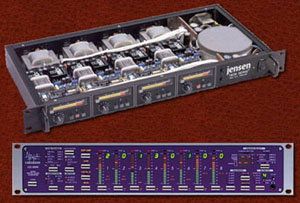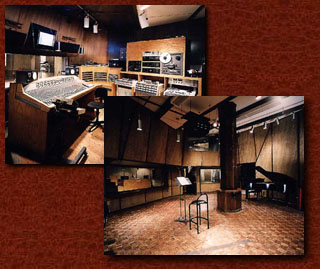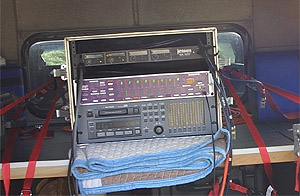|
For Real
Techno Geeks
 Son
of a Wanted Man was recorded directly into a Pro Tools 24
Mix Plus system at 24 bits and at a sampling rate of 44.1.
Although higher rates were available we wanted a direct
relationship to what we would put onto CD so while 88.2
(not available at the time) would have been acceptable,
the 48 and 96 rates were not. Son
of a Wanted Man was recorded directly into a Pro Tools 24
Mix Plus system at 24 bits and at a sampling rate of 44.1.
Although higher rates were available we wanted a direct
relationship to what we would put onto CD so while 88.2
(not available at the time) would have been acceptable,
the 48 and 96 rates were not.
 In
the studio we used four Sennheiser MKH Cardioid microphones
which are known for their high output and smooth off-axis
sound. The mics were connected into the studio’s wiring
using an experimental cable made by our friend Ken Goerres.
The studio cabling was Belden. In
the studio we used four Sennheiser MKH Cardioid microphones
which are known for their high output and smooth off-axis
sound. The mics were connected into the studio’s wiring
using an experimental cable made by our friend Ken Goerres.
The studio cabling was Belden.
 Once
in the control room we ran each of the four mic lines into
a Jensen Twin Servo pre amp and then through a “Y” connector
into two separate channels of an Apogee ADA 8000 eight channel
digital converter. This meant that each of the mic signals
now appeared on two channels of the converter. One of these
channels was adjusted down 7 db so that if an actor got
too loud we could later edit in the lower channel for a
clean recording. This didn’t work as well as we would have
liked and if there is a next time we’ll probably make it
10 db and put a mild limiter on it. Once
in the control room we ran each of the four mic lines into
a Jensen Twin Servo pre amp and then through a “Y” connector
into two separate channels of an Apogee ADA 8000 eight channel
digital converter. This meant that each of the mic signals
now appeared on two channels of the converter. One of these
channels was adjusted down 7 db so that if an actor got
too loud we could later edit in the lower channel for a
clean recording. This didn’t work as well as we would have
liked and if there is a next time we’ll probably make it
10 db and put a mild limiter on it.
 The
studio we recorded in was a pentagon about thirty feet across
the center. It was also about twenty feet tall (a real plus
as the greater volume of air in the studio and the more
distant the walls, ceiling and floor, the better it seems
to sound) and had alternating hard and soft wall panels.
There was a big column right in the center and the room
had an off-center (obviously) sweet spot about fifteen feet
in diameter. We set up our mics at the corners of a six
foot square inside that sweet spot. This allowed the actors
to be able to see each other and gave us room inside the
six foot square to set up mic and music stands and to run
wires, etc. The
studio we recorded in was a pentagon about thirty feet across
the center. It was also about twenty feet tall (a real plus
as the greater volume of air in the studio and the more
distant the walls, ceiling and floor, the better it seems
to sound) and had alternating hard and soft wall panels.
There was a big column right in the center and the room
had an off-center (obviously) sweet spot about fifteen feet
in diameter. We set up our mics at the corners of a six
foot square inside that sweet spot. This allowed the actors
to be able to see each other and gave us room inside the
six foot square to set up mic and music stands and to run
wires, etc.
When we went looking for a studio
we tested each room by setting up two mics back to back
and then reading dialogue into one of them at various levels.
We’d usually test two to four spots in a potential studio
then go home and play them back listening for the smoothest
sound in the mic that was not being spoken into.
This told us whether we would end up with mic to mic bleed
that sounded rough and like we were in a recording studio.
We chose the studio that sounded the smoothest and most
neutral.
When the day came to record we
ordered some baffles to go between the mics to give us more
separation but we discovered that the studio we were working
in, J. E. Sound in Hollywood, sounded so good that the baffles
were completely unnecessary.
Scenes were recorded with the
actors overlapping each other’s lines although we occasionally
went in and got sections with no overlap if we thought we’d
need them in editing … I can’t remember if this was ever
necessary. By the end of the session we had so much material
that worrying about overlap was probably useless.
 While
the scenes were all recorded into the computer’s hard disk
we also left an 8 track digital tape machine (Tascam DA-78)
running the whole time we were in the studio, whether we
were performing a scene or not. This is a trick we learned
on Merrano of the Dry Country. At one point we had needed
an extra bit of dialogue to flesh out a scene; we found
it in some idle conversation that we accidentally recorded
while our actors were eating lunch! While
the scenes were all recorded into the computer’s hard disk
we also left an 8 track digital tape machine (Tascam DA-78)
running the whole time we were in the studio, whether we
were performing a scene or not. This is a trick we learned
on Merrano of the Dry Country. At one point we had needed
an extra bit of dialogue to flesh out a scene; we found
it in some idle conversation that we accidentally recorded
while our actors were eating lunch!
 When
recording sound effects in the field we used the Tascam
8 track digital recorder, our 8 channel converter (the ADA
8000), the Jensen mic pre amp, whatever length of Ken’s
great cable we needed and again the Sennheiser microphones.
We figured that using mics in the same series as we used
for the voice recordings in the studio would help create
a consistency of sound that would help the audience believe
that both the effect and the voice had been in the same
place at the same time. The Sennheisers are also pretty
indestructible. When
recording sound effects in the field we used the Tascam
8 track digital recorder, our 8 channel converter (the ADA
8000), the Jensen mic pre amp, whatever length of Ken’s
great cable we needed and again the Sennheiser microphones.
We figured that using mics in the same series as we used
for the voice recordings in the studio would help create
a consistency of sound that would help the audience believe
that both the effect and the voice had been in the same
place at the same time. The Sennheisers are also pretty
indestructible.
For power I modified my truck
to charge an additional pair of Optima 12 volt batteries
which fed a Pro Sine pure sine wave power inverter. This
gave us semi portable (in the back of a 4x4 pick up) 120v
power that is cleaner than what comes out of the wall.
 All
our ambiance recordings were done in stereo using an O.R.T.F.
mic configuration. The specific effects were recorded using
a mid/side mic array (or M/S) and the recordings were not
decoded into stereo until the time came to mix the scene.
This allowed us to “steer” the center channel left and right
with a pan pot and to bring an effect nearer or farther
using the mid channel volume control … the “size” of the
stereo image can be controlled with the side channel volume
control. We came up with this process on Merrano of the
Dry Country about ten years ago and as far as we know we’re
the only ones to ever use it. It gives us an unbelievable
ability to move, a sound effect around within the stereo
sound field of the scene. All
our ambiance recordings were done in stereo using an O.R.T.F.
mic configuration. The specific effects were recorded using
a mid/side mic array (or M/S) and the recordings were not
decoded into stereo until the time came to mix the scene.
This allowed us to “steer” the center channel left and right
with a pan pot and to bring an effect nearer or farther
using the mid channel volume control … the “size” of the
stereo image can be controlled with the side channel volume
control. We came up with this process on Merrano of the
Dry Country about ten years ago and as far as we know we’re
the only ones to ever use it. It gives us an unbelievable
ability to move, a sound effect around within the stereo
sound field of the scene.
Our studio equipment is pretty
basic, not much more than a fully loaded Pro Tools 24 Mix
Plus system. However, except for the air conditioning, the
room itself is one of the best monitoring environments we’ve
ever seen. It’s just a rectangular room built on the back
of a garage but it was built exactly to the recommended
dimensions in my old text book, Audio In Media. The front
of the room has some sound control panels but that’s about
all. Somehow the room ended up testing so flat that I’ve
had speaker manufacturers use it to test their new designs.
Accidental but very fortuitous.
We use a set of monitors and sub
woofers made by Ken Goerres and always monitor the program
at exactly the same level. All of the equipment in the studio
has been modified to connect at the same level and we use
one, specially built, set of VU meters set to that “studio
level.”
Our monitor amps are made by Power
Physics (ultra fast, binary switching, analogue amplifiers
is a way to describe them). Our studio engineer,
Howard Gale, has modified certain aspects of the amps for
better performance and better integration with the sub woofers.
We use Ken’s home-made cabling throughout the studio and
that includes some special power cords he makes up. All
the AC current comes through a “Balanced Power” system,
eliminating virtually all grounding noise. We have discovered
that the better our monitoring system and the better our
wiring, the less we want to EQ anything … it seems the lesson
here is; when in doubt, leave it alone!
There are lots of improvements
that could be made in Son of a Wanted Man, we learned an
incredible amount as we worked. Technically, there are also
a fair number of flaws in the show that were totally avoidable.
In several places we used an inferior quality recording
because the performance was better. This is a no-brainer
for us; if you get the emotion, who cares about the sound.
We never did get the conditions right to record really good
horse effects. Hooves sound best on cold hard ground
and we never got ourselves out at the right time to record
the best possible horse effects. Because of the limited
number of “voices” or channels in the Pro Tools system we
started out with we had to print or “bounce” our dialogue
tracks to buy space in the computer … this created an extra
digital generation that would be unnecessary today. Some
people think that digital generations don’t count and therefore
don’t worry about them. However, I do notice the sound getting
a little hard as the generations mount up … so, whenever
possible, I think it’s best to keep from combining things
until the last moment.
Son of a Wanted Man was mastered
by Bob Katz at Digital
Domain. Bob gave us great advice as we worked and I
consider it a really good idea to involve the advice of
a mastering engineer in each step along the way. His website,
articles, text book, and Bob himself, were a great asset
to us.
|
